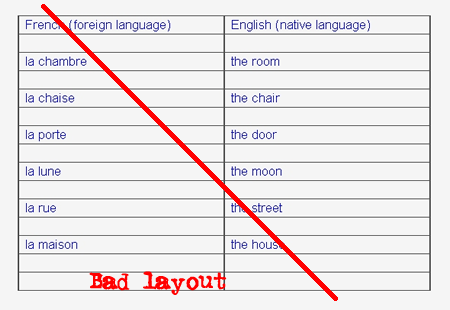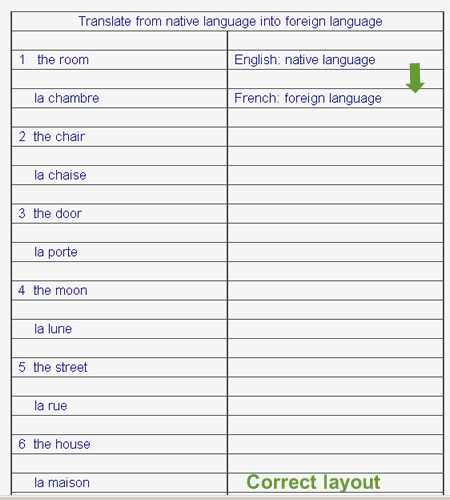
|
Dr Klaus Bung
© 2010 Klaus Bung
Klaus Bung:
|
| French (foreign language) | English (native language) |
| la chambre | the room |
| la chaise | the chair |
| la porte | the door |
| la lune | the moon |
| la rue | the street |
| la maison |
the house |
The student has to learn to understand (or imagine) "door" when he hears "la porte", and to say "la porte" when he thinks of "door".
Or to put it differently, he has to translate "porte" into "door" and "door" into "porte".
In even more general terms, the student learns to associate (connect) "porte" with "door"; e.g. porte = door
I am explaining all this here not in order to teach you how to learn vocabulary, but in order to teach you the technical terms which are used to discuss the procedure; e.g. associate, connect, native language, foreign language, translate, input, output, source language, target language, language 1, language 2, etc.
We associate two objects or symbols by considering them as a pair, to things which belong together. One way of writing this down is this:
"Pair" can be used in normal language and as a mathematical term.
In normal language, you can talk about "a pair of trousers" (which in other languages is often a singular), "a pair of scissors", "a pair of spectacles", "a pair of shoes", "a pair of socks" etc.
If two people (usually male and female) become friends and eventually become best friends or more, other people might say: "John and Mary are now a pair."
Sometimes, in the radio news, "pair" is used in a slightly derogatory way. Let's assume a case like "Bonny and Clyde" were reported on the news in England. It might sound like this: "A man and a woman wearing balaclavas robbed a bank in Gretna Green and then made off in a white van across the border into England. Two hours later they were spotted in Preston. The pair are believed to be heading towards London where they are planning to kidnap Tony Blair and sell him to Osama bint Laden".
By saying "The pair are believed ..." instead of "The two are believed ...", or "The robbers are believed ..." or "The fugitives are believed ...", the newscaster indicates subtly that these two people are not to be trusted, not quite "kosher", that there is something wrong about them. The word "pair" is only SLIGHTLY derogatory, and I have also heard it used without being derogatory at all.
Counter-example: British Prime Minister David Cameron and his wife Samantha spent their summer holiday in Cornwall. The press reported about it, and especially that, while they were on holiday, Samantha Cameron gave birth to a baby.
The press would never have said: "The PAIR decided to spend their holiday in Cornwall" or "The PAIR were over the moon with joy and decided to name the new-born girl 'Florence Rose Endellion'."
The press could have said all that because it is true, but they would not have referred to the Prime Minister and his wife as "the pair".
They could, however, have said: "The COUPLE were over the moon with joy and decided to name the new-born girl 'Florence Rose Endellion'."
There are more differences between "pair" and "couple" but we cannot explore all of them here. You can say: "I want a couple of books" (i.e. two books), but NOT: "I want a pair of books". The two members of a pair belong closely together. "A couple" also belongs closely together, e.g. "a married couple". But "a couple of ..." is just a relaxed way of saying "two". Similarly "some books" is a relaxed way of saying "several books".
Now let's turn to "pair" in mathematics
You can link any two objects or symbols and thus create a pair. For example, you can link the letters of the alphabet and the cardinal numbers and create a set of pairs. In that case the notation is as follows:
(a,1), (b,2), (c,3), ...
Or you can link each cardinal number with its double:
(1,2), (2,4), (3,6), (4,8), ...
Or you can link the names of countries with their capitals, and you get:
(Egypt, Cairo), (Syria, Damascus), (UK, London), (Spain, Madrid), (France, Paris), (India, New Delhi), (China, Beijing), ...
So it is clear now why we call the English and French words in the exercise "pairs". Each pair has two members. The members of the pair (la porte, the door) are "la porte" and "the door".
It is the purpose of such exercises to make us associate the members of each pair with each other. There is a branch of learning psychology studying how this is done. It is called "paired-associate learning".
The advice given by VOCPROC is that, prior to learning, the student should write down the pairs in a specific format. He should not write the members of each pair side by side (horizontally).
NOT:

But he should write the members of each pair above each other and leave a blank line below each written line; and he should start with his mother tongue; thus (if the mother tongue is English):

The student has to translate from English into French.
How do we express this in more general terms so that it can apply to ANY student and to ANY "pair of languages", and how do we express that the student has to write one word above the other? Which word of each pair comes first?
It would make sense to call the top line (English in our example) the "question" and the bottom line (French in our example) the "answer".
The top line can be seen as an abbreviated form of the answer.
1 the room / question
la chambre / answer
is equivalent to
1 Question: How do you say "the room" in French?
Model answer: "la chambre"
But some readers will get confused by this terminology, since they may regard "the room" as a word (or two words) and not as a question. Normally a question is a full sentence and ends in a question mark.
Therefore we now try other ways of denoting the top line and the bottom line of each item.
(In DYLL, an item is the same as a pair, namely a "question", sometimes in abbreviated form, and a "model answer".)
If you are a psychologist or know something about psychology, you will like the terms (stimulus, response), again a pair.
To each stimulus belongs a response.
Examples:
Shakespeare in his "Merchant of Venice" (Act 3, Scene 1) has also made a contribution to stimulus/response observations.
Shylock, a Jew, complains about the bad inhuman treatment of Jews, as if Jews had no feelings and did not feel pain like other human beings. In a famous speech, he gives a number of examples.
Here is Shakespeare's original text. If you are very good at English, you can try to understand at least most of it. If you are not so good, see how many words you can understand. Otherwise, continue reading after the end of this text.
SHYLOCK To bait fish withal: if it will feed nothing else, it will feed
my revenge. He hath disgraced me, and hindered me half a million;
laughed at my losses, mocked at my gains, scorned my nation, thwarted my
bargains, cooled my friends, heated mine enemies; and what's his reason?
I am a Jew. Hath not a Jew eyes? hath not a Jew hands, organs,
dimensions, senses, affections, passions? fed with the same food, hurt
with the same weapons, subject to the same diseases, healed by the same
means, warmed and cooled by the same winter and summer, as a Christian
is? If you prick us, do we not bleed? if you tickle us, do we not laugh?
if you poison us, do we not die? and if you wrong us, shall we not
revenge? If we are like you in the rest, we will resemble you in that.
If a Jew wrong a Christian, what is his humility? Revenge. If a
Christian wrong a Jew, what should his sufferance be by Christian
example? Why, revenge. The villany you teach me, I will execute, and it
shall go hard but I will better the instruction.
Now I will extract from this text some statements and put them into extremely simple English:
In brief, a Jew behaves like any other human being. If you apply a stimulus to a Jew or to a Christian, the response will be the same. You cannot tell the difference.
Now we can set up a (stimulus, response) relationship, a set of pairs: (stab a man, he bleeds), (tickle a man, he laughs), (poison a man, he dies), (comit a crime against a man, he takes revenge)
The relationship between all kinds of mental stimuli ( = plural of stimulus) and their responses has been studied in many psychological experiments. Have a look at the work of behaviourist B F Skinner, who has contributed a lot to educational theory but nowadays is not loved by everybody ( = is not flavour of the month), especially not by linguists..
In this terminology, we can say that the standard lay-out for DYLL requires the stimulus to be written above the response. The stimulus is in the student's mother tongue, and the response is to be given in the language he wants to learn. That gives him practice.
1 the room / stimulus
la chambre / response
The word "response" is almost the same as "answer". In conversation it is sometimes is paired with "question".
Example:
A policeman asks a suspect: "Where did you get these explosives?" The response is ( = The answer is): "Get stuffed," i.e. go to hell, to put it mildly.
You could describe this incident by saying: "The question was x, and the response was y", but you could never say in such a case "The stimulus was x."
(stimulus, response) as a pair are only used when talking about scientific experiments, not in ordinary conversation. But the word "response" alone occurs very frequently in normal conversation.
To be continued in Part 2 on 13 Sep 2010 - Watch this space!
